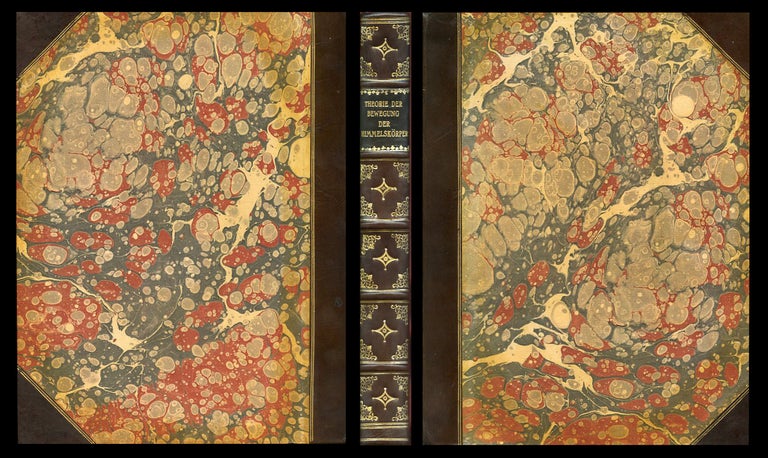Theorie der Bewegung der Himmelskörper welche in Kegelschnitten die Sonne umlaufen
Hanover: Carl Meyer, 1865. 1st German Edition. HANDSOMELY BOUND FIRST GERMAN EDITION (INCLUSIVE OF ITS ORIGINAL WRAPS) OF GAUSS’ MASTERFUL WORK ON CELESTIAL MECHANICS & MATHEMATICAL STATISTICS. The work was first published in Latin in 1809 as "Theoria motus corporum coelestium in sectinibus conicis solem ambientum” [“Theory of the Motion of the Heavenly Bodies Moving about the Sun in Conic Sections”].
Gauss’ work systematically develops his methods of orbital calculation and demonstrated his ability to accurately calculate and predict orbital location, including the theory and use of least squares,” which is here applied for the first time (DSB). It introduced the Gaussian gravitational constant along with the first application of the normal distribution to observational errors” (History of Science: The Wenner Collection). The astronomical methodology Gauss described in Theory Motus required only a few modifications for use with computers and is still in use today.
Gauss believed that “the problem of finding the orbit that connects two position vectors in a certain time” was “among the most important in the theory of the motions of the heavenly bodies” (Roa, Regularization in Orbital Mechanics, 233). “On January 1, 1801, the Italian astronomer Giuseppe Piazzi discovered Ceres and was able to track its path for 40 days before it was lost in the glare of the sun. Based on this data, it was desired to determine the location of Ceres after it emerged from behind the sun without solving the complicated Kepler's nonlinear equations of planetary motion” (Hald: History of Mathematical Statistics 1750-1930, pp.351-357).
That same year, 1801, a 24 year old Gauss calculated the orbit of the asteroid Ceres with great precision based on what most scientists thought was inadequate data. The astroid was found near Gauss’ predicted position by von Zach, a Hungarian astronomer and the German astronomer Heinrich Wilhelm Matthias Olbers. Many predictions had been made, but only Gauss’ least-squares analysis allowed von Zach and Olbers to determine Ceres’ location.
“When Olbers asked Gauss how he made the orbit calculation, Gauss sent him an essay in 1802 describing his methods. The essay was finally published in 1809 in von Zach’s journal, Monatliche Correspondenz [and contained] a set of linear equations that are described as the beginning of linear algebra… Gauss went on to further develop his analytical methodology for predicting orbital motion and published this in 1809 in a work titled Theoria Motus” (Wenner).
In the first part of Theoria Motus, Gauss “dealt with differential equations, conic sections and elliptic orbits, while in the second part, the main part of the work, he showed how to estimate and then to refine the estimation of a planet's orbit using a new method involving minimizing the sum of squared residuals, e.g., the method of least squares. He was able to prove the correctness of the method under the assumption of normally distributed errors. It is here that the Gaussian curve, expressing statistical distribution in probability, makes its appearance” (Hald).
The German mathematician Johann Carl Friedrich Gauss (1777–1855) was “a truly original mathematician and scientist…, the last great mathematician to be called the prince of mathematicians’ (Princeton Companion: Mathematics, 756). Gauss was “admired as much for his breadth as for the depth of his insights and the fertility of his ideas” (ibid). Item #983
CONDITION & DETAILS: Hannover: Carl Meyer. 4to. 11.25 x 8.75 inches. [4], xvi, [279], 72, [4]. 2 original photographs (the Gauss Medal) mounted as frontispiece. 3 plates; 6 tables. Handsomely rebound in period leather over marbled boards; 5 raised bands at the tilted-lettered and -tooled spine. Original wraps bound within. Institutional stamp on front wrap, otherwise fine condition in every way.
Price: $1,800.00

